February 16th, 2022 by IISG
Location: Carmel, Indiana
Organization: Clay Middle School
Grade: 6th
Subject: Science
Why do you think it’s important to infuse Great Lakes topics in education?
Invasive species pose a threat to our ecosystems, and our Great Lakes. My students are gaining an understanding of the fragility of those species we love to find in the Great Lakes and also how dangerous new invasive species would be if introduced to the Great Lakes.
Describe one of your favorite classroom experiences or activities associated with the Great Lakes.
“Everywhere we look, there are species damaging our natural ecosystems both now, and as we look into the future.” Sixth grade science students at Clay Middle School were tasked with coming up with creative solutions for solving these ecological problems. Students presented to members of the local scientific community who are on the front lines of Indiana’s invasive species problems. Members of this professional audience included scientists from the following institutions: Indiana Department of Natural Resources, Purdue University, Illinois-Indiana Sea Grant, Carmel Clay Parks and Recreation, Indiana Department of Transportation, Southern Indiana Cooperative Invasives Management, Hamilton County Invasives Partnership, Hamilton Soil and Water Conservation District, and USDA National Resources Conservation Service.
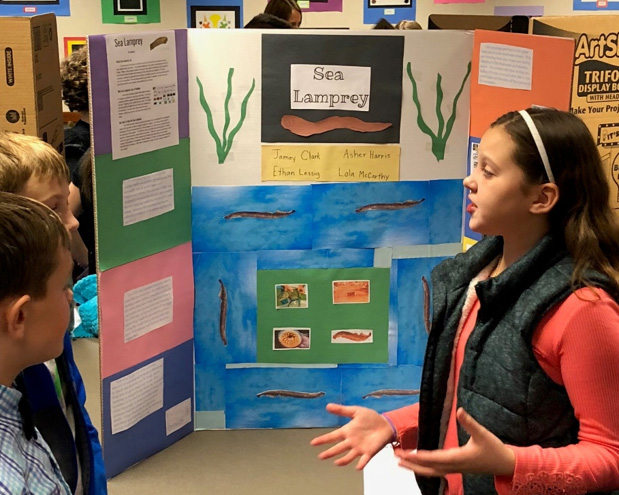
Students speak about sea lamprey problems and solutions at a student-led Invasive Species Symposium at Clay Middle School. (Photo provided by Steve Sturgis)
What teaching methods do you use to engage students in Great Lakes activities?
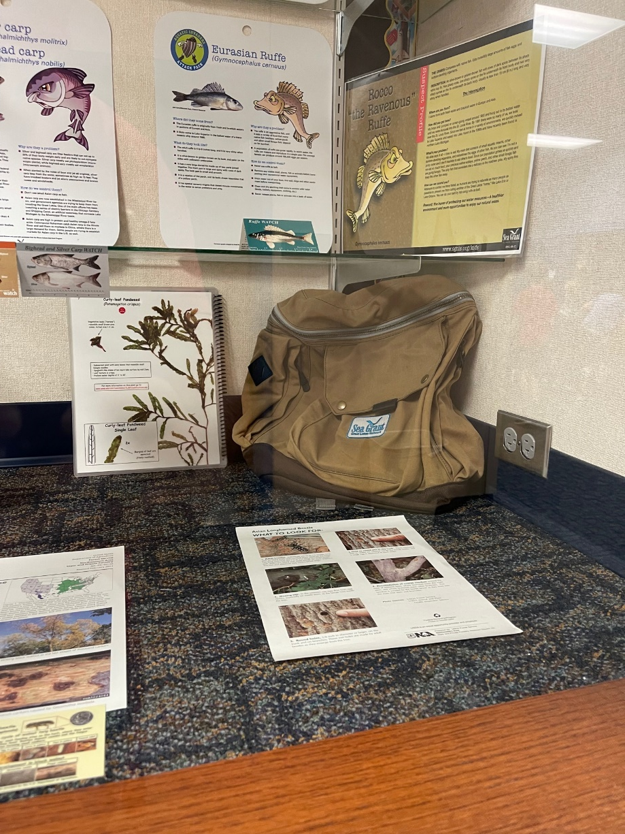
Sea Grant’s Attack Pack resources are a Center for Great Lakes Literacy classroom supplement to invasive species Project Based Learning. (Photo provided by Steve Sturgis)
Project Based Learning or PBL. Creating projects centered around solving real problems creates a natural opportunity for students to learn curriculum in a more meaningful and engaging environment for learning.
How have you involved scientists in your teaching?
At the end of our PBL study “Invasive Species, Can They Be Stopped?” students present their unique solutions to the invasive species problem to a professional panel that consists of members of agencies that work directly with invasive species in the local community.
Student Reflections on Great Lakes stewardship
“I had no idea how many invasive species Indiana had wrecking ecosystems. This project was a fun way to learn about a species and come up with a clever way that scientists could maybe use someday to stop these invaders.” – Student at Clay Middle School
Illinois-Indiana Sea Grant is a part of University of Illinois Extension and Purdue Extension.
Contact: Steve Sturgis, ssturgis@ccs.k12.in.us
Education and Student Engagement Coordinator: Terri Hallesy
Center for Great Lakes Literacy: https://www.cgll.org/teacherfeature/steve-sturgis/
January 5th, 2022 by IISG
“Meet Our Grad Student Scholars” is an article series from Illinois-Indiana Sea Grant (IISG) celebrating the graduate students doing research funded by the IISG scholars program. To learn more about our faculty and graduate student funding opportunities, visit our Fellowships & Scholarships page.
Alexandra (Ali) Touloupas is a master’s student in Plant Biology and Conservation joint program with Northwestern University and the Chicago Botanic Garden, and is part of the inaugural Illinois-Indiana Sea Grant Graduate Student Scholars cohort. She is interested in rare plant conservation and the impacts of climate change on bog and fen species. Her work involves monitoring and modeling rare plant distributions, and how critical habitat may be impacted by climate change. Ali has earned two bachelor’s degrees, learning about Plant Biology from North Carolina State University and Sociology from Mount Holyoke College. Ali enjoys hiking and exploring new natural areas, and stopping in antique stores along the way.
As a master’s student and scientist who studies rare plant species, Alexandra (Ali) Touloupas has partnered with the Chicago Botanic Garden to record current populations and predict how rare plant species may respond to climate change. This project has many components, some of which require Touloupas to survey rare species, model habitat suitability, calculate statistical predictions, and predict future climate scenarios in wetlands.
The rare plants Touloupas studies are considered high priority species. These species were chosen by expert ecologists and botanists because more data is needed to update their conservation status. Last year, she worked as a research assistant for the Plants of Concern program at Chicago Botanic Garden, coordinating and conducting rare plant monitoring throughout Cook County during the field season. In late fall, she analyzed annual monitoring data to detect population trends. This position helped Touloupas understand the potential impact of her work on rare plant monitoring initiatives.
A typical research day for her depends on the season. In the summer, she does a lot of hands-on field work and sometimes turns into a modern-day Sherlock Holmes to find a specific plant. According to Touloupas, the detective work that goes into determining the locations of rare species is sometimes daunting but always fun. First, she looks for the last known coordinates of her species by accessing records from the Illinois Natural Heritage website. The data and coordinates can only be accessed through a confidentiality agreement to protect rare plants and their habitats from trampling and poaching. Then, she uses a GPS to get herself to the location. This can be tricky for a few reasons; bogs and wetlands are hard to move through, even when someone knows where they are going. And while getting stuck in the muck with boots sinking into the ground, Touloupas must be careful not to disturb the fragile habitat.
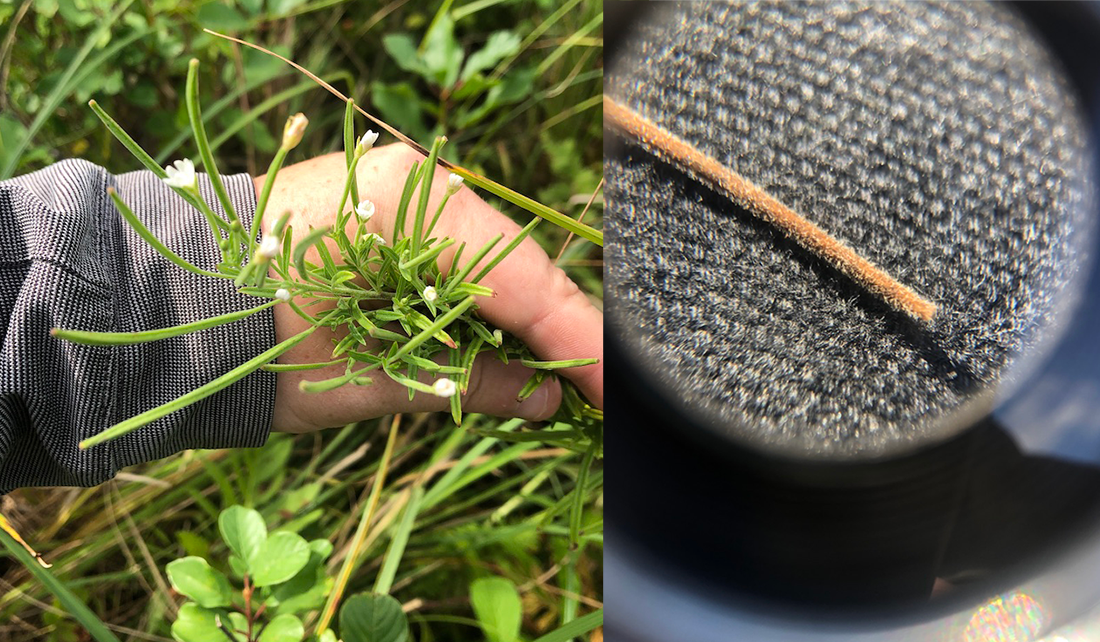
Using a hand lens is crucial to see the dense hairs that distinguish this species that Touloupas is studying, Epilobium strictum, from other species. (Photo provided by Alexandra Touloupas)
Last summer, she drove long distances to get to field locations and sometimes even camped overnight near the sites. The plants she is focused on live in bogs and fens—wetlands that accumulate lots of peat and runoff. Certain indicator species, which have adapted to the harsh conditions, help Touloupas know she is getting closer to her rare plants… or at least where they used to be. Some of the species she hunts for were last seen 50 years ago, so she never knows what she will find.
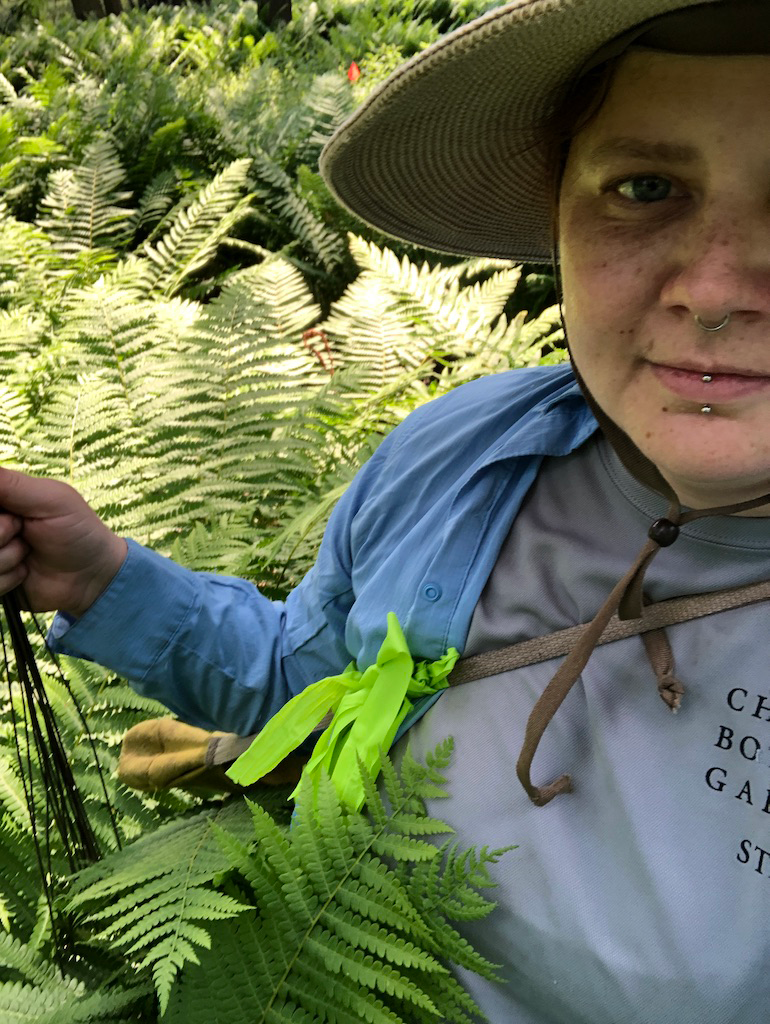
Sometimes Ali has to wade through ferns and other flora nearly as tall as she is when looking for rare species, as shown here during field work for Chicago Botanic Garden’s Plants of Concern program. (Photo provided by Alexandra Touloupas)
A lot can happen over 50 years, including immense ecological changes. For example, cattails take over what was once a diverse bog, or an invasive animal could eat a whole population of plants. When Touloupas finds a rare plant species, she takes their new GPS coordinates as well as detailed notes and photos. Nothing is too small to be observed. She notes if plants are growing on a slope, in shade or sun, and especially looks for things that might not allow for long-term survival. Because ecological landscapes are always changing, she also takes note of small signs that indicate what might become of the sites, particularly if new bogs and fens are forming.
The next phase of Touloupas’ research is to process the data she collected during her fieldwork. She plans to incorporate the spatial data she collected about rare plants into possible climate change scenarios. Since climate change is so complex, Touloupas must compile scenarios with many different variables. She chose to include temperature and precipitation, soil type and soil characteristics, acidity of soil, and relationships to geology and glaciers. To understand conditions that enable her species to persist, Touloupas uses information from GIS datasets and remote sensing images. Land use will also be factored into the scenarios, including distances from developments that may produce harmful runoff, because wetlands are particularly sensitive to pollutants. Ultimately, Touloupas plants to contextualize her findings in various climate scenarios, like those created by the Intergovernmental Panel on Climate Change.
One of her proudest accomplishments is learning how to process data with the R coding language. She is using GIS mapping and R to model possible futures for her rare plants. To do this, she uses statistical analysis and strategic model selection. When she has combined all her results together, Touloupas plans to share best practices with organizations that want to conserve rare plants, such as suggesting sites where the plants could be reintroduced.
When she started graduate school, Touloupas thought of it as a career move and personal milestone that would secure an appealing job. After some time at Northwestern, she was surprised to find that graduate school itself is lots of fun. Being back in academia, around other people doing research and learning from their processes, has inspired her to dig into the field. She is particularly thankful for the support for her own research. She feels more empowered to do plant biology work and is even considering more research in the future.
To any aspiring plant scientists, Touloupas recommends gaining experience by working seasonal jobs or completing internships to test different roles and find something inspiring. “Find what you like and what works best for you,” she said. “Listen to podcasts and lectures, either in person or online, to get inspired by other people’s research and to see what’s possible. There is a lot of creativity that goes into designing a research project.”
Touloupas learned about the rare plants she is studying by taking classes during the first part of her degree. The graduate-level courses involved plenty of literature reviews, through which she learned about the latest research in plant biology. Additionally, folx who have worked in the areas for decades took students into the field to share their data collection processes and tips. She also tried to absorb all the information she could through books like “A Great Lakes Wetland Flora” and a few key organizations. The Illinois Wildflowers website, US Department of Agriculture and Illinois Natural History Survey resources were particularly helpful. Touloupas hopes that the final results of her study will end up help in one of these public resources.
You can learn more about the exciting research that Ali is conducting at Northwestern University by following @aktouloupas on Twitter and big_al_botany on Instagram.
Illinois-Indiana Sea Grant is a part of University of Illinois Extension and Purdue Extension.
Writer: Sarah Gediman
Contact: Carolyn Foley
December 29th, 2021 by IISG
“Meet Our Grad Student Scholars” is an article series from Illinois-Indiana Sea Grant (IISG) celebrating the graduate students doing research funded by the IISG scholars program. To learn more about our faculty and graduate student opportunities for funding, visit our Fellowships & Scholarships page.
Jordan Holtswarth-Hartman is a PhD student in Natural Resources and Environmental Sciences at the University of Illinois at Urbana-Champaign, and part of the inaugural Illinois-Indiana Sea Grant Graduate Student Scholars cohort. She is interested in ecology and conservation and is currently looking at the impacts of Banded Killifish, a native transplant species in the Illinois-Indiana area. Jordan earned her bachelor’s degree in Fisheries and Wildlife from the University of Missouri – Columbia, and her MS in Biology from Tennessee Technological University, where she studied the transferability of habitat suitability models for freshwater mussels in Missouri. Jordan is an avid yogi and coffee enthusiast, and a mom to cat Ghost and bunny Luna.
PhD student Jordan Holtswarth-Hartman is studying the relationships between Eastern and Western Banded Killifish. She is comparing their ecological roles as well as whether the two are hybridizing, or breeding together. While their names indicate they live on opposite sides of North America, the two subspecies of Banded Killifish have come to inhabit much of the same territory over the past 20 years.
Western Banded Killifish typically live in kettle lakes, which are fed by underground rivers and streams. While originally from the eastern coast of the United States, not much is known about how the Eastern Banded Killifish became more common than its western counterpart in Lake Michigan and the Illinois River. Because Eastern and Western Banded Killifish look so similar, Holtswarth-Hartman needs to use stable isotopes and genetics to determine the ecological roles—the importance or function they play in the ecosystem—of the subspecies and whether they are hybridizing.
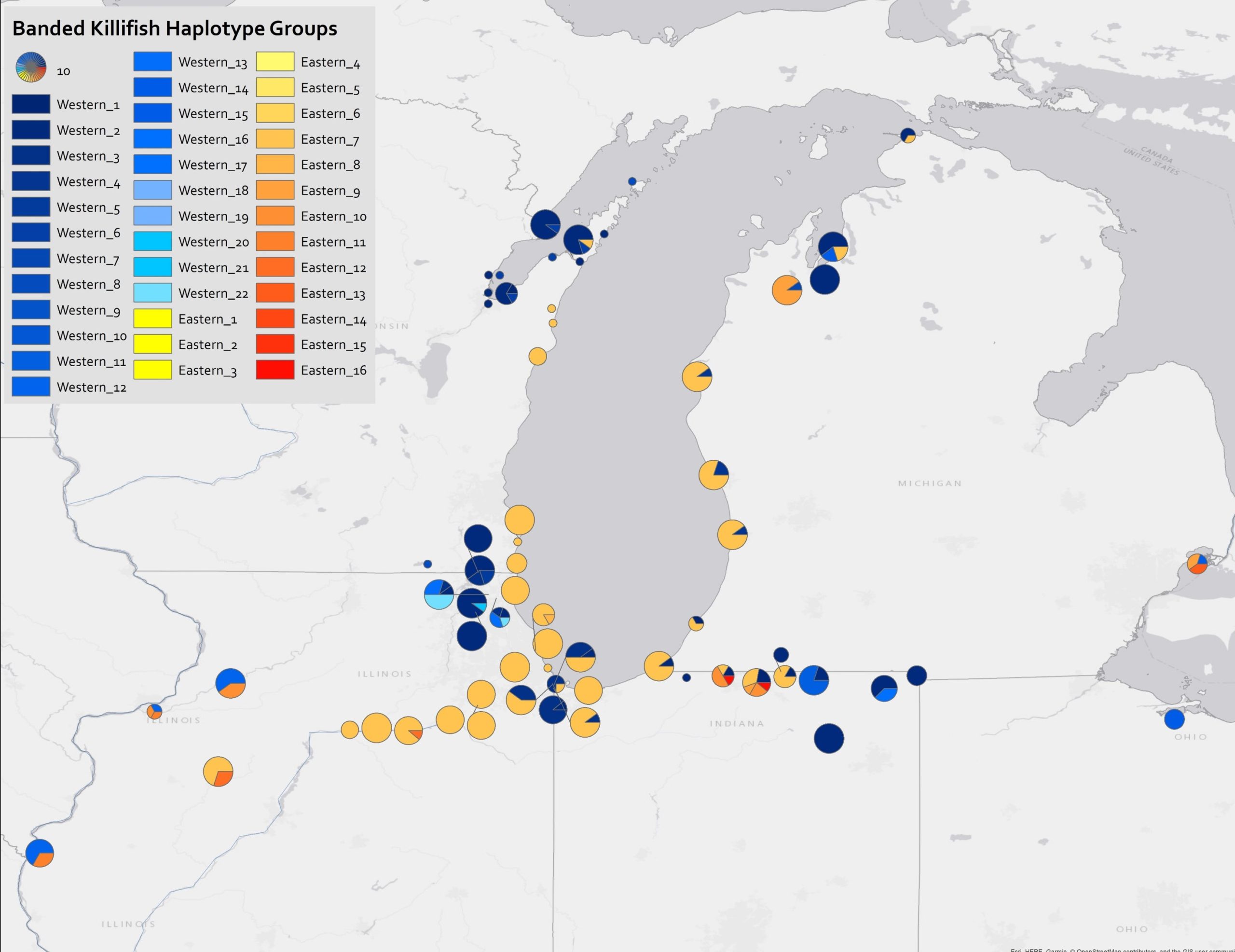
(Graphic provided by Larson Lab / University of Illinois at Urbana-Champaign)
So, what does it mean that at least some of the Banded Killifish are changing their habitats? Holtswarth-Hartman and the principal investigator on her project, Eric Larson, use the term native transplant to refer to species that are from the United States but have been moved outside their native range. Banded Killifish are also considered non-game fish, meaning there are no sport or commercial uses for them. There are an estimated 236 non-game, native transplants in the United States; they play an important ecological role in the greater Illinois-Indiana region, but are relatively under-studied.
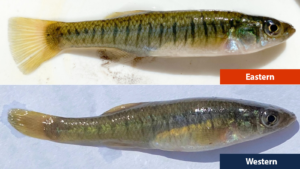
Jordan Holtswarth-Hartman of the Larson Lab is investigating the eastern banded killifish in the southern Lake Michigan region, a non-native lookalike of the native, Illinois state threatened western banded killifish. (Larson Lab / University of Illinois at Urbana-Champaign)
Holtswarth-Hartman is working with 727 fish samples, so the detail-oriented lab work she is completing is time-consuming but necessary to reach her research objectives. She has two main goals: first, to determine the trophic position of the two subspecies using stable isotopes; and second, to determine whether they are hybridizing using genetics.
A trophic position is an organism’s place in a food web, and helps define its ecological niche. Stable isotopes are two or more forms of the same element which have different numbers of neutrons. They are stable because they do not decay over time. Stable isotope values in muscle tissue differ based on diet, meaning Holtswarth-Hartman can deduce what fish eat and therefore where on the food chain they are. This gives a picture of the long-term diet, but there is another technique, called gut metabarcoding, that can reveal what the fish ate shortly before they were caught.
Holtswarth-Hartman studies the hybridization and genetics of Banded Killifish using a combination of mtDNA and RAD sequencing. Mitochondrial DNA, or mtDNA, is inherited from the mother, and tells Holtswarth-Hartman whether the fish is an Eastern or Western subspecies. However, because mtDNA is only inherited from the mother, it cannot be known if the fish is a hybrid. Once Holtswarth-Hartman knows the subspecies of the mother, she uses Restriction site Associated, or RAD, sequencing to determine if an individual fish is a hybrid. RAD sequencing uses nuclear DNA by looking at the polymorphic loci, or a set of DNA in which multiple alleles determine a single trait. When there is at least one allele from the mom and at least one allele from the dad, Holtswarth-Hartman can see if there is a combination of DNA from Eastern and Western subspecies.
While genetics have become a key part of her project, Holtswarth-Hartman did not have any background in the field before starting her PhD. Now, she says she has developed a love for genetics and has included three different genetic aspects in her project. “I have really enjoyed broadening my knowledge in many different areas such as genetics and sample collection,” Holtswarth-Hartman said. “On a personal level, I have been fortunate to build close relationships with new mentors and friends that have been a major help with all aspects of my PhD.” After she earns her doctorate, Holtswarth-Hartman is thinking about jobs in academia, government or for NGOs where she can apply her skills in habitat suitability modeling and genetics.
You can learn more about the exciting research that Jordan is conducting in the Larson Lab at University of Illinois Urbana-Champaign by following @JordanHHartman on Twitter or browsing her publications on Google Scholar or ResearchGate.
Illinois-Indiana Sea Grant is a part of University of Illinois Extension and Purdue Extension.
Writer: Sarah Gediman
Contact: Carolyn Foley
December 17th, 2021 by IISG
CSMI, or the Cooperative Science and Monitoring Initiative, is an internationally-supported endeavor to collect and process data about the Great Lakes. Each year, scientists study a different Laurentian Great Lake. They spend up to a month on ships for their research, and to work together to answer broad questions about the health of the lake, generating data and information to help improve environmental management.
Lake Michigan was scheduled to be sampled in 2020, so IISG hosted the kickoff workshop funded by the International Joint Commission in 2018 to discuss sampling priorities. Unfortunately, the COVID pandemic delayed sampling, so in 2021 CSMI research focused on both Lake Michigan and Lake Superior, meaning ships and people had to split their time between the two lakes. While COVID protocols remained in place, researchers were tenacious and gathered exciting data.
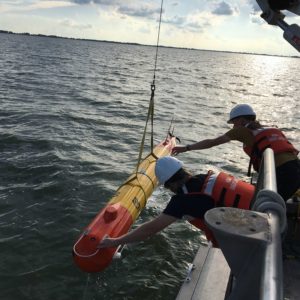
Long-range autonomous underwater vehicles can sample 24 hours a day, seven days a week, for as much as a couple of weeks at a time according to David Warner of USGS. (NOAA Great Lakes Environmental Research Laboratory)
A key theme during 2021 sampling of Lake Michigan was to collect data from a broader area than had been done during previous field years. While physical researchers and biologists from the NOAA Great Lakes Environmental Research Laboratory (NOAA-GLERL) deployed buoys and autonomous underwater vehicles—and conducted larval fish and other biotic sampling—off the coast of the long-sampled Muskegon, Michigan transect, researchers from the EPA Great Lakes Toxicology and Ecology Division Laboratory (EPA-GLTED), the USGS Great Lakes Science Center (USGS-GLSC) and other organizations also sampled extensively in the less-studied northern portion of Lake Michigan, plus included sampling of Green Bay and Grand Traverse Bay.
This intentional effort on the part of the researchers was designed to make the most of the longer-term datasets from the southern portion of the lake, while also filling in important data gaps to increase overall understanding of Lake Michigan ecosystems.
With regard to longer-term sampling, biologists from Buffalo State College, the EPA-GLTED office and NOAA-GLERL all gathered samples to explore the lower food web, including phytoplankton, zooplankton and benthic macroinvertebrates. Many of these sampling efforts are similar to Lake Michigan sampling efforts in 2010 and 2015, including using a benthic sled to assess benthic communities. Repeating sampling at the same locations, in the same ways, can help biologists understand if the food web makeup is changing or remaining the same.
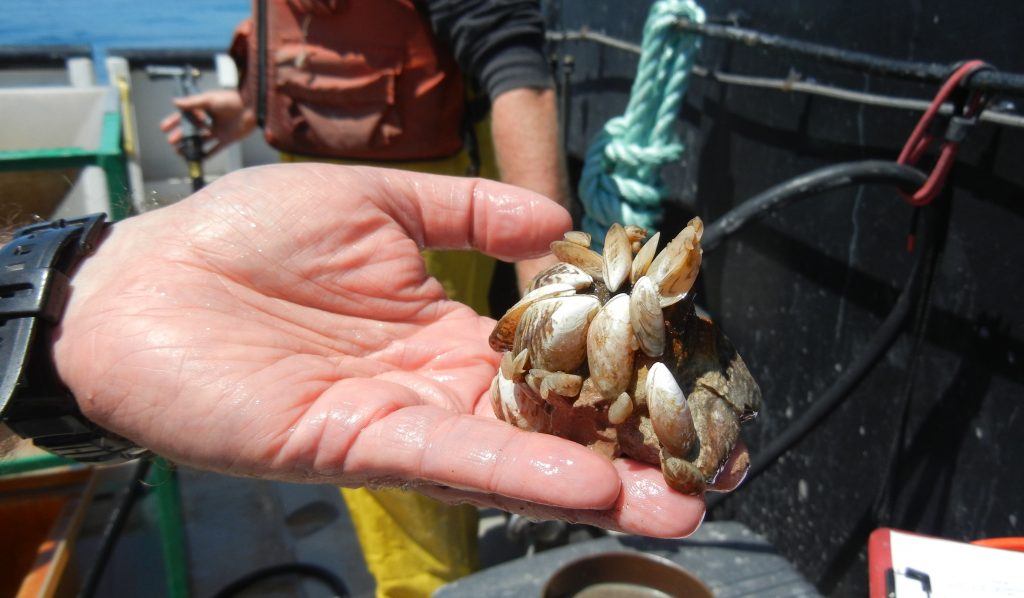
Rock covered in quagga mussels, collected in a Ponar grab in Lake Michigan during the 2015 CSMI benthic survey. (NOAA Great Lakes Environmental Research Laboratory)
NOAA-GLERL scientists also continue to explore the biology of invasive quagga mussels. Quagga mussels, which have largely replaced zebra mussels across the Great Lakes, have completely reengineered Lake Michigan by altering phytoplankton dynamics, providing new sources of food for other Lake Michigan organisms, and altering habitat characteristics along the lake bottom.
In 2021, a NOAA-GLERL-led team is focused specifically on assessing quagga mussel length-weight relationships and reproductive status. They are also examining veligers, which are very small, young mussels that are almost microscopic. The veliger stage is the only time that quagga mussels move freely with currents, and small fish and zooplankton likely take advantage of veligers as a food source.
Scientists from Wayne State University worked with NOAA-GLERL researchers to see if laboratory-reared larval yellow perch that were fed veligers performed less well than those fed other zooplankton. Preliminary results suggest that feeding on veligers can negatively affect larval yellow perch growth, making it important to gain a greater understanding of when and where veligers are available for organisms to eat so that scientists can understand the growth of all Lake Michigan fishes.
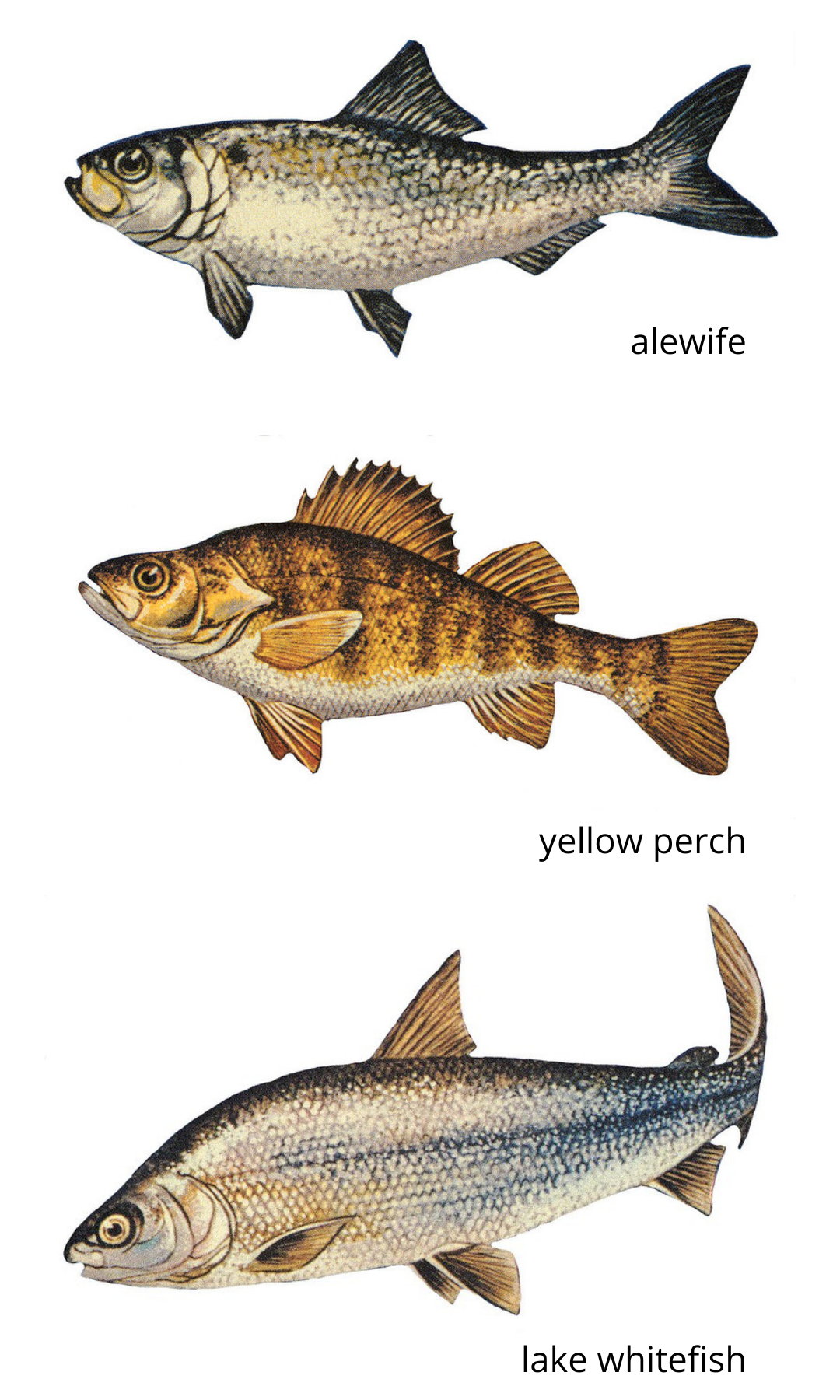
(NOOA Great Lakes Environmental Research Laboratory)
One of the most exciting efforts of the 2021 Lake Michigan CSMI sampling year is a major push to understand distributions and growth of young fish, including alewives, yellow perch and lake whitefish. Sampling conducted during the 2015 CSMI effort found that larval alewife growth in Lake Michigan had slowed about 40% since the early 2000s. Alewife are ecologically critical prey for larger fishes in Lake Michigan, and it is unclear if slower growth rates are related to food availability, food quality or other factors.
A team led by NOAA-GLERL did an intensive study along the Muskegon, Michigan transect to assess dynamics of all available larval and juvenile fish, including assessing the importance of night and day, depth, distance from shore and a large number of physical and abiotic variables, such as temperature and dissolved oxygen, on fish diets and growth. The team plans to combine their findings with efforts by the USGS Great Lakes Science Center and the EPA Great Lakes Toxicology and Ecology Division Laboratory, who in July sampled 15 transects across all of Lake Michigan for plankton and larval fish.
At each transect, the EPA team also measured the depth that UV radiation now penetrates. Water clarity in Lake Michigan has increased over the past 15 years, in part because quagga mussels have expanded to deeper portions of the lake, and it is possible that UV rays harm larval fish. This is likely the largest spatial coverage for larval fish sampling that has ever been undertaken in Lake Michigan, and nicely showcases what can happen when sampling among organizations is coordinated.
In early 2021, the USGS Great Lakes Science Center conducted weekly sampling of larval lake whitefish and available zooplankton prey along the beaches of St. Joseph and South Haven, Michigan; the southernmost locations in Lake Michigan to be sampled for lake whitefish larvae. By combining the results from these efforts with long-term lake whitefish beach sampling studies conducted by NOAA-GLERL and the Little Traverse Bay Bands of Odawa Indians (LTBB), scientists will better understand whether lake whitefish recruitment could be limited by zooplankton prey in their first weeks of life.
Purdue University scientists were also able to examine diets of larval whitefish collected from 2015 through 2019 by the LTBB, after samples were graciously provided, and plan to assess diet and growth patterns of larval alewife collected in southeastern Lake Michigan in 2021. All teams are eager to learn more about the larval fish community in the coming months as they shift from intensive field sampling to laboratory processing: measuring larval fishes, counting what is in their diets, and assessing growth.
The studies summarized here are far from the only efforts by scientists to understand Lake Michigan in 2021. Physical scientists at NOAA-GLERL deployed buoys and autonomous underwater vehicles to collect physical, chemical and biological observations in Lake Michigan, and NOAA-GLERL modelers created biophysical models to help visualize the movement of water and predict the locations of larval fish. USGS-GLSC scientists leveraged the existing Great Lakes Acoustic Observation System (GLATOS) network to better understand how lake whitefish and cisco select their habitats, and biologists were out as late as November 2021, tagging fish that will be tracked through 2022.
Scientists from several different partner organizations will use indicators like stable isotope ratios in organisms to determine food web structure, and further understand how energy is passed among Lake Michigan organisms. Illinois-Indiana Sea Grant looks forward to working with CSMI scientists to share the results of their work through online materials, presentations at conferences and written reports. To learn more about the 2015 CSMI Lake Michigan Field Year results, explore the story map Lake Michigan Health: A Deeper Dive.
Illinois-Indiana Sea Grant is a part of University of Illinois Extension and Purdue Extension.
Writer: Carolyn Foley
Contact: Paris Collingsworth
December 6th, 2021 by IISG
In this abbreviated interview, Colette Copic and Rachel Egly of the Keller Lab at Loyola University Chicago tell Illinois-Indiana Sea Grant Communications Associate Sarah Gediman about their research to contain invasive aquatic invertebrates. The team tested barriers on bloody red shrimp (Hemimysis anomala), zebra and quagga mussels (Dreissena spp.), rusty crayfish (Faxonius rusticus), red swamp crayfish (Procambarus clarkii), marbled crayfish (Procambarus virginalis), bladder snail (Physella acuta), Chinese Mystery Snail (Bellamya chinensis), Daphnia magna, and Hyalella azteca. While some of these species are not invasive, they served as substitutes for similar species that could become invasive.

Colette Copic (left) and Rachel Egly (right). (Keller Lab)
How did you become interested in studying aquatic barriers?
Egly: We have worked with several aquatic invasive species, but we were inspired by the current electric barrier in the Chicago Sanitary and Ship Canal. So far, this barrier has succeeded in blocking Asian carp, which can disrupt entire ecosystems and economies, from entering Lake Michigan. While this has worked well for Asian carp, we aren’t sure how electric barriers affect other types of organisms.

The first of three electric barriers in the Chicago Sanitary and Ship Canal was installed in 2002. (Sarah Gross / U.S. Army Corps of Engineers Chicago District)
Our lab was funded by Illinois-Indiana Sea Grant to look at how aquatic invasive invertebrates might respond to electric barriers and other methods of abating invasive species. I have been testing barriers using various strengths of electrical current, and Colette has been testing barriers made from carbon dioxide (CO2). We chose aquatic invasive species that have the potential to drastically change ecosystems should they become established populations.
Copic: Part of our motivation behind this project is that the scope is immense— canals are everywhere, and they aren’t going away anytime soon. We need them for trade, flooding management, and to be resilient to climate change, but every canal brings a free-flowing path for invasive species. If we can create canal management systems that allow ecosystem integrity, then this project has global implications. The question we want to answer is how we can have non-physical barriers in these canals so ships can pass through, but invasive species cannot.
We know electric barriers work, but what made you decide to test CO2 as a barrier?
Copic: The whole reason we’re thinking about this at all is that we know Asian carp avoid water with high CO2 concentrations in both the lab and the field. As I learned that, I thought, could this be a catch-all for other invasive species? Relative to other pesticides and biocides that we can use in water, CO2 is non-toxic and dissipates naturally. It won’t kill everything like a lot of other methods of keeping invasive species out, but it can immobilize and kill certain organisms, some of which are invasive.
How did you measure the efficacy of electric barrier and CO2 barrier techniques on your subject organisms?
Copic: I did two types of experiments. The first was in simple tanks to look at what behavioral effects carbon dioxide has on these creatures when they can’t escape. I tested their behavior on a range of carbon dioxide concentrations by observing the animals minute-by-minute in tanks with differing amounts of CO2. After recording the organisms, I got an idea of each species’ tolerance to CO2. Some become immobilized (wholly or partially), some are unaffected, and some die.
I also tested species that are mobile and can move across water to see if, given the choice, they would avoid high concentrations of carbon dioxide. I recorded where they were in the tank and saw that as levels of CO2 rise in one chamber, the animals will move to the chamber with lower levels of CO2.
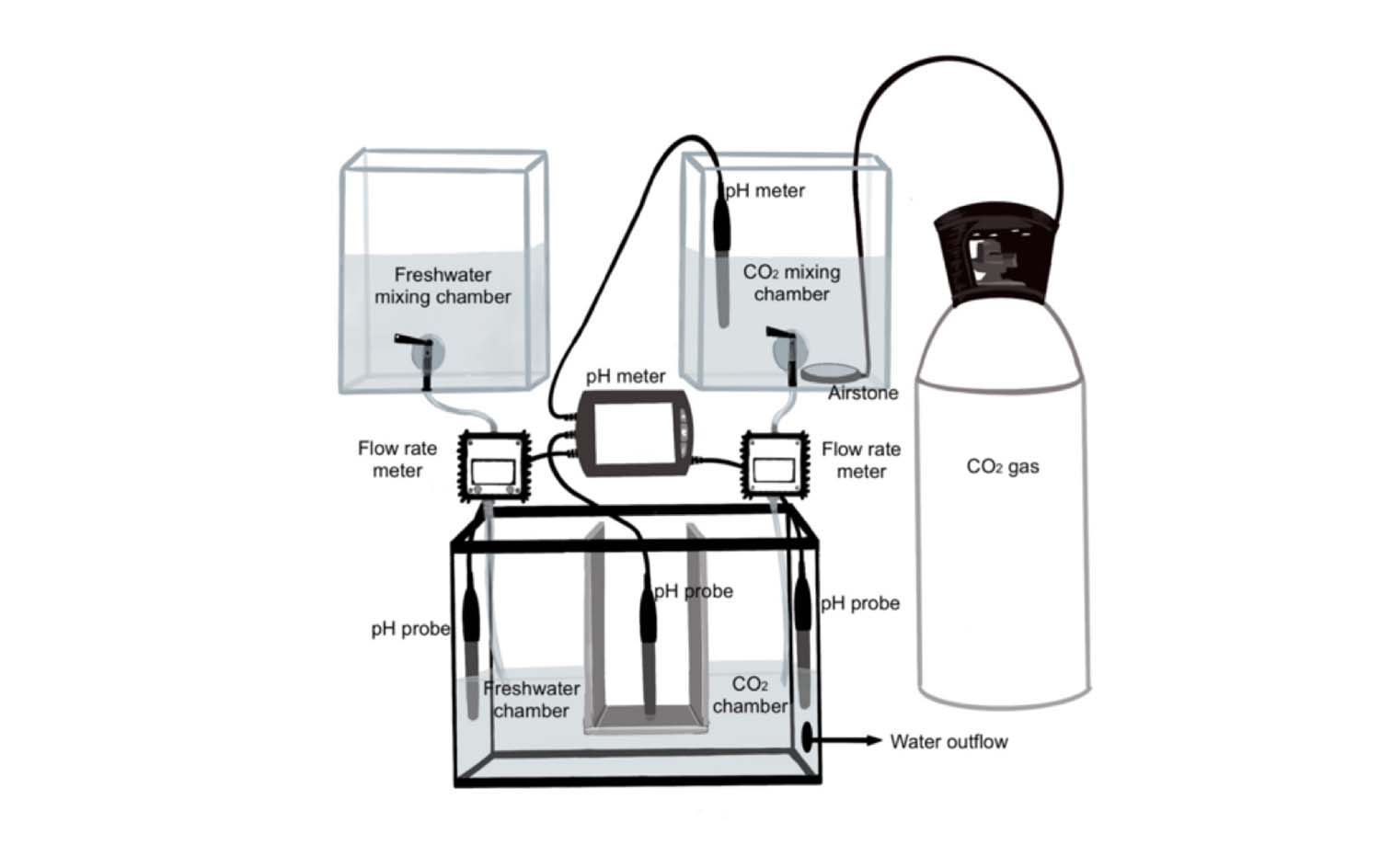
Diagram of tank arena to test carbon dioxide concentrations on mobile animals. (Keller Lab)
Egly: Like Colette, I measured by behavioral analysis, with similar results. Here is a diagram of the lab-scale electric fields used to mimic the one in the Chicago Sanitary and Ship Canal. We put wires on either side of a large fish tank and ran electricity between one steel plate electrode and the other, which created an electric field.
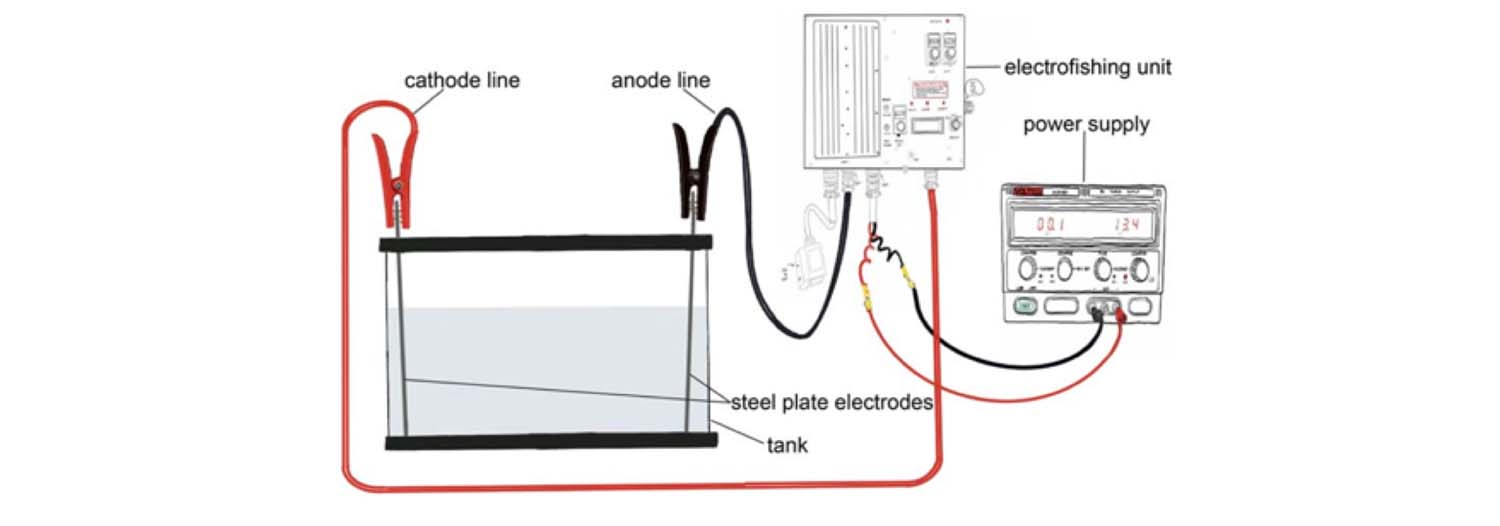
Diagram of experimental electric barrier setup, including power supply, electrofishing unit, tank, steel plate electrodes, and cathode and anode lines. (Keller Lab)

Diagram of electric barrier structure installed in the Chicago Sanitary and Ship Canal. (U.S. Army Corps of Engineers Chicago District)
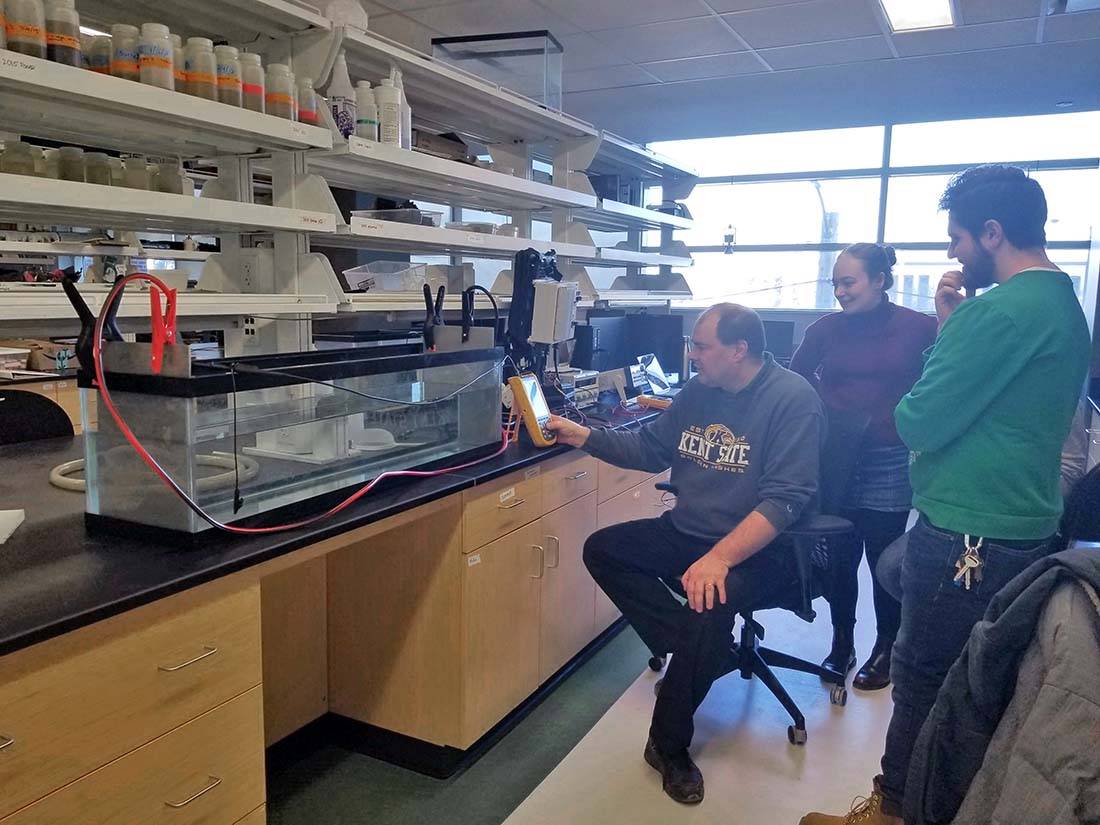
Researchers test the electric barrier setup at Loyola University. (Keller Lab)
What happens, ideally, when an organism comes into contact with CO2 or electrical currents?
Copic: I called the effect I saw narcotization because the CO2 was almost like a sedative. The crayfish would lose all muscle abilities and locomotive skills at higher CO2 concentrations. You could see they were experiencing stress as they got stiff, and some became completely frozen. I’d even poke them every five minutes and there would be no response. But then after just 10 minutes in fresh water without heightened CO2 concentrations, they were moving normally and it’s like it never happened.
Egly: I also found that even if the animals don’t exhibit a behavioral response such as lack of consciousness or motion, they still tend to orient themselves perpendicular to the electric barrier. So, we know that they’re feeling something, and they reduce their chance of being electrocuted by avoiding the barrier. We found that different species have different resistance to the electric barrier, so there is no single “ideal” strength of the electric field. The same is true for CO2 — different species react differently. Our results show that there is great promise for each of these types of barriers if the strength of each can be optimized.
What would these barrier systems look like in a real canal?
Egly: New electric barriers would look a lot like the current one in the Chicago Sanitary and Ship Canal, but with various amounts of electricity. In the existing structure, there are steel cables laid underneath the canal through which electricity is run to create a permeable division in the form of an electric field. This can be recreated in canals in many parts of the world.
Copic: Carbon dioxide really hasn’t been used much, so it’s tough to say. I’ve heard ideas about bubbling CO2 gas directly into strategic, small areas of the canal almost like a curtain. I’ve also heard the idea of having tanks on the side of canals, pumping CO2 and water inside, and releasing the mixture into canals when there is a high risk of species transmission. For example, when the shipping locks are open, or when electric barriers fail because they’re susceptible to power outages and might need maintenance.
You can learn more about the exciting research that Colette and Rachel are conducting in the Keller Lab at Loyola University Chicago by following @Craychel_Egly and @ColetteCopic on Twitter.
Illinois-Indiana Sea Grant is a part of University of Illinois Extension and Purdue Extension.
November 8th, 2021 by IISG
In the face of climate change, scientific literacy among people in all professions is critical to a resilient community. To help make information accessible, Illinois-Indiana Sea Grant (IISG) specialists Kara Salazar and Leslie Doworth have teamed up with Melissa Widhalm—formerly of Purdue Climate Change Research Center, currently with the Midwestern Regional Climate Center—to author a series of publications about climate change in Indiana. The team drew on their backgrounds in community planning, water quality and climate change, respectively, to consolidate important information about the local effects of climate change and how to address them.
They chose four areas of focus based on feedback from various stakeholders associated with the Purdue Land Use Team and community planning program efforts through IISG and Purdue Extension. Throughout these four publications, the most recent climate science data are presented in topics such as precipitation and temperature extremes. There are also introductions to community planning frameworks, such as the One Water approach, and resources to support communicating about climate to diverse audiences.
“The problem of climate change is far reaching, but there are many strategies communities can implement to manage impacts,” said Kara Salazar, IISG’s assistant program leader and extension specialist for sustainable communities. “The more that decision makers, and the public as a whole, understand how global climate change will impact our communities, the better we can adjust local natural resources management and planning efforts.”
The climate publications are an updated version of documents originally published by the (now retired) Purdue Planning with POWER (protecting our water and environmental resources) Program over ten years ago. Since then, researchers’ understanding of how climate change will manifest locally has deepened dramatically. The new resources include recent research and expectations about local change that are tailored for Indiana communities.
The authors hope that these publications will be a valuable educational resource for local government officials, plan commission members and anyone with an interest in the climate and environment. Salazar said, “They can be a way for anyone to have an introduction to the topic.” For those who are interested in community planning in the face of climate change in or around Indiana, this is the place to start.
Illinois-Indiana Sea Grant is a part of University of Illinois Extension and Purdue Extension.
Writer: Sarah Gediman
Contacts: Kara Salazar, Leslie Dorworth
October 13th, 2021 by IISG
Scientists must always be ready to adapt to changing circumstances, but the COVID-19 pandemic presented new, completely unforeseen challenges. Illinois-Indiana Sea Grant (IISG) funded researchers persevered through stay-at-home orders, social distancing guidelines and the threat of severe illness to further, and even enhance, their original projects. Many of these scientists are affiliated with more than one institution, and research teams are sometimes working across state lines so conflicting COVID-compliance guidelines between locations added to the confusion. Even so, scientists at every stage of research found the tenacity to continue meaningful inquiry despite pandemic-related complications.
One research team, from the University of Illinois at Chicago (UIC) Van Meter Lab, had planned to study the potential for road salt to infiltrate groundwater via green infrastructure installments. They were unable to collect new data but found a creative alternative—they used historical Illinois Tollway data to start their investigation of runoff’s impact on groundwater. This intellectual detour not only allowed them to keep researching during the pandemic but will also contextualize the new data this team will eventually collect. The UIC team is not the only one to use historical records.
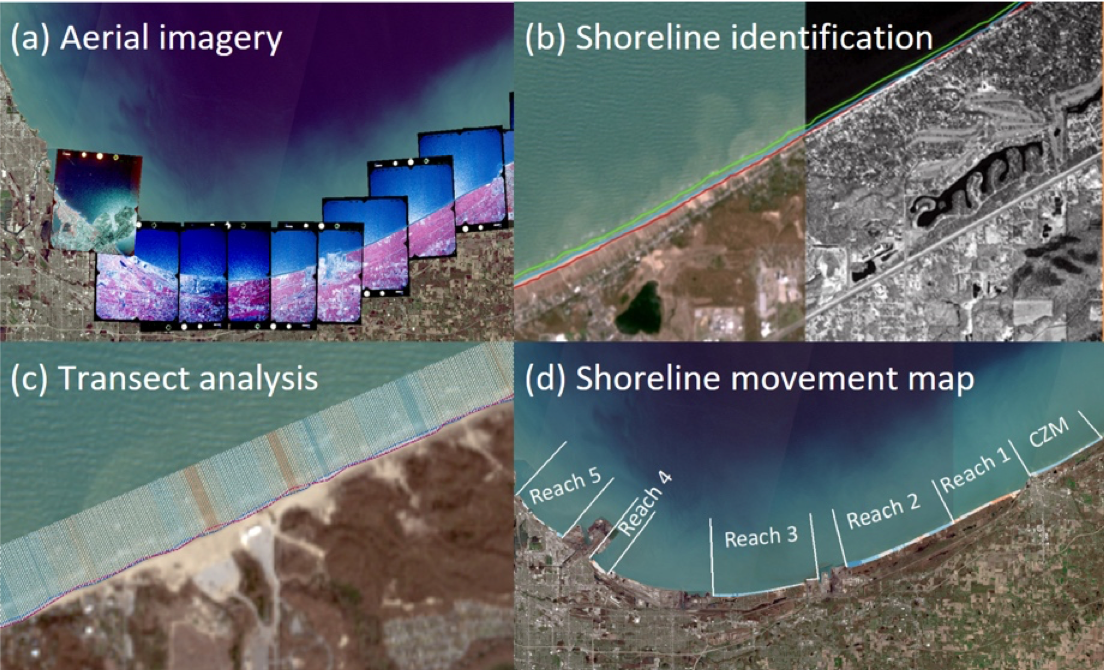 Another IISG-supported team—the Troy Lab at Purdue University—used aerial photos of Lake Michigan taken between 1964 and 2019 and spanning the entire Indiana shoreline to understand which areas are more or less prone to erosion over time. Together with partners from Wisconsin and Michigan, the researchers aim to inform future shoreline conservation efforts around the lake. Though they were eager to get out and gather current shoreline images and erosion data, their work, while bound to the lab, laid a strong foundation for the project.
Another IISG-supported team—the Troy Lab at Purdue University—used aerial photos of Lake Michigan taken between 1964 and 2019 and spanning the entire Indiana shoreline to understand which areas are more or less prone to erosion over time. Together with partners from Wisconsin and Michigan, the researchers aim to inform future shoreline conservation efforts around the lake. Though they were eager to get out and gather current shoreline images and erosion data, their work, while bound to the lab, laid a strong foundation for the project.
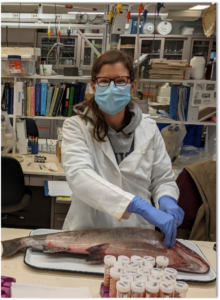
Notre Dame ecologist studies sportfish.
A team based at the University of Notre Dame Stream and Wetland Ecology Lab is studying per-and-polyfluoroalkyl substances (PFAS) – a contaminant of emerging concern in the Great Lakes that can cause great harm to sportfish and the people who eat them. They had initially planned to sample a large range of sportfish caught by various partners, including the United States Geological Survey, but social distancing guidelines made the planned collections through large-scale boating trips impossible. However, the Notre Dame team contacted biologists who were able to pass along sample fish from their respective small trips, allowing research to continue despite the limitations on collection procedures. The generosity of the freshwater biologists allowed the lab group to continue their work and strengthened personal ties in the field, creating valuable networking that will outlast the pandemic.
William Bianco’s team from Indiana University had planned to connect with people in person to discuss climate readiness but switched to the standard virtual format when the pandemic started. Instead of being hindered by the technology, his group found that the success of conducting remote interviews with local communities could allow them to share their climate resilience expertise with even more people in the future.
After two years of data collection, a team led by Piotr Cienciala at University of Illinois at Urbana-Champaign (UIUC) found themselves unable to collect their third and final data set while maintaining social distancing. This group was studying the way that water turbulence and stream construction affects the energy fish use to swim. Instead of collecting new data, the UIUC team decided to process the numbers they had collected over the past two years. In doing so, they avoided working physically close to fish suppliers and technicians, and developed the coding models to evaluate both present and future data.
IISG supports researchers who are committed to understanding and caring for the Great Lakes, Lake Michigan and southern Lake Michigan communities. During a time that challenged the world’s resilience, values and patience, these researchers remained committed to their important work.
Illinois-Indiana Sea Grant is a part of University of Illinois Extension and Purdue Extension.
Writer: Sarah Gediman
Contact: Carolyn Foley
September 22nd, 2021 by IISG
Sea Grant announced three initiatives this week, all focused on freshwater systems and management. Projects include managing stormwater to reduce flooding in the Great Lakes, examining contaminants of emerging concern along the East Coast and mitigating pollution resulting from runoff in the mid-Atlantic region.
“Sea Grant’s latest investments demonstrate our commitment to address knowledge gaps to improve the management of freshwater resources at the interface of both coastal and Great Lakes environments,” said National Sea Grant College Program Director Jonathan Pennock. “These initial efforts will identify the key challenges and inform strategies to be implemented by the Sea Grant network related to contaminants of emerging concern, runoff pollution and flood resilience.”
Illinois-Indiana, Minnesota and Pennsylvania Sea Grant programs will lead a collaborative effort to implement multi-benefit green infrastructure in marginalized neighborhoods across the Great Lakes. This initiative, which is supported in partnership with the NOAA Climate Program Office, is aimed at improving the resilience of vulnerable Great Lakes communities to the impacts of flooding through equitable and inclusive stormwater and floodplain management.
The project will identify vulnerable communities and their associated climate challenges in Michigan City and Hammond, Ind.; Duluth, Minn.; and Erie, Pa. Visioning exercises for implementing green infrastructure will be informed by this assessment along with listening sessions and focus groups with municipal and community leaders.
A competitive research program administered by Connecticut Sea Grant will examine methods for addressing the presence and effects of contaminants of emerging concern (CECs) in aquatic environments and affiliated coastal environments. CECs, such as pharmaceuticals, personal care or household cleaning products, industrial chemicals and microfibers, are increasingly detected in surface water and groundwater, posing risks to the nation’s drinking waters and aquatic life. The consequences of these contaminants are projected to increase in the future without better understanding and mitigation.
The Atlantic coast regional research initiative will welcome a combination of natural and social science approaches to address CECs. This work will also incorporate environmental justice considerations and public education. Finally, the project team will define a strategic national role for Sea Grant on the topic of CECs through literature review, comprehensive surveys and regional workshops.
New Jersey Sea Grant Consortium will administer a competitive research program to examine innovative techniques and the use of low-impact development and green infrastructure practices for mitigating runoff and pollution impacts on freshwater systems and their downstream environments. The mid-Atlantic regional research initiative will integrate existing knowledge, expert opinions, and stakeholders’ comments to reduce runoff and abate runoff pollution-related environmental, economic and social issues. In addition to improving water management and creating new economic opportunities, this work will ensure equitable access to freshwater for urban community residents, particularly from underrepresented and economically disadvantaged groups. This project will also develop a living strategic document that discerns the roles of the Sea Grant Network and various government agencies in this arena.
These two competitive research programs with Connecticut Sea Grant and New Jersey Sea Grant Consortium are the result of congressional direction to support research initiatives related to both CECs and runoff pollution. Furthermore, they address priorities for Sea Grant from the 10-Year NOAA Sea Grant Water Resources Vision. Each effort was awarded $850,000 in federal funds and both grant recipients must match 50 percent of their funding with non-federal funds.
Learn more about Sea Grant’s work in Healthy Coastal Ecosystems and Resilient Communities and Economies.
Illinois-Indiana Sea Grant is a part of University of Illinois Extension and Purdue Extension.
Writer: Hallee Meltzer, National Sea Grant College Program
September 17th, 2021 by IISG
SPRINGFIELD, IL – The Directors of the Illinois Department of Agriculture and Illinois Environmental Protection Agency (EPA) are announcing the release of Illinois’ third Nutrient Loss Reduction Strategy (NLRS) Biennial Report. The Report describes the continued progress being made in Illinois as well as challenges to reduce nutrient losses from multiple sources to improve water quality in Illinois and downstream to reduce the hypoxic zone in the Gulf of Mexico.
The 2015 Illinois NLRS established a goal to reduce the amount of nitrogen and phosphorus in Illinois waterways by 45%, with interim reduction goals of 15% nitrate-nitrogen and 25% total phosphorus by 2025. Implementation of the statewide Strategy is guided by the Illinois EPA, Illinois Department of Agriculture, and University of Illinois Extension with the Policy Working Group and other stakeholder groups and councils. Like other states, Illinois faced unprecedented challenges, including extreme flooding in 2019, followed by the global pandemic in 2020. Despite these events, partner organizations, working both collaboratively and independently, remained committed to the Strategy with the assistance of virtual meetings and continued engagement.
“The report highlights the progress we are making in programs like our cover crop incentive program, Fall Covers for Spring Savings,” said Jerry Costello II, Department of Agriculture Director. “This program is creating awareness and encouraging Illinois’ farmers to look at methods that will reduce nutrient loss.”
“The 2021 Biennial Report highlights accomplishments and new efforts from each sector, which were noteworthy given the increase in precipitation events experienced in Illinois and other states within the Mississippi River basin,” said Illinois EPA Director John Kim. “Work continues by all partners to incorporate additional recommended practices to achieve needed nutrient reductions. We remain committed to the goals established in the 2015 Strategy and look forward to continuing our efforts alongside all stakeholders as we address these challenges.”
It has been evident that additional resources, outreach, and land and facility improvements are necessary to meet the Strategy’s main object of improved water quality in Illinois. Illinois has seen progress in application of agricultural conservation practices, wastewater treatment plant improvements, and government support at the local/watershed level. That said, shifting climate conditions require the need for continued reductions from all sectors.
During 2019-2020, the agriculture sector reported spending nearly $27 million implementing the Strategy outside of traditional government cost-share programs. In addition, the Nutrient Research and Education Council invested $6.9 million for nutrient research and education programs. During that same period, over 72,000 people attended more than 1,020 outreach events including field days, conferences, or workshops to learn about practices that can be implemented to reduce nutrient loss from farm fields.
Through its Partners for Conservation cost-share program, the Illinois Department of Agriculture assisted farmers by redirecting funds to implement an additional 93,750 acres of cover crops after a historic flooding in 2019. The Department’s Fall Covers for Spring Savings program also supported 50,000 additional acres of cover crops in 2019. This year’s report shows Illinois farmers are reporting increased knowledge of the Strategy, which resulted in an increase in cover crops, with 1.4 million acres planted, representing a 135% increase from 2011. Illinois also saw a significant decrease in phosphorus fertilizer application rates in 2019 with 11.2 million acres of croplands reported as having less applied compared to 2011.
Spending by the point source sector increased significantly from $65.1 million in 2019 to $185.2 million in 2020. Point source sector reductions are largely regulated through Illinois EPA’s National Pollutant Discharge Elimination System permit program, with 36% of major municipal wastewater treatment facilities having permit limits for total phosphorus. Facilities are taking additional steps, and since 2018 have developed 71 nutrient reduction optimization studies and 59 nutrient reduction feasibility studies. Outreach and education have also continued in the point source sector with 13 events held, reaching more than 2,600 stakeholders.
Illinois EPA’s Water Pollution Control Loan Program continues to provide low-interest loans for wastewater treatment plant upgrades. In 2019 and 2020, Illinois EPA invested over $200.2 million to projects to improve nutrient removal, green infrastructure, urban stormwater treatment, and control of combined and sanitary sewer overflows.
Thanks to online platforms, the urban stormwater sector continued to reach a broad audience of more than 14,000 stakeholders, sharing tips for homeowners to reduce nutrient loses from their property. Additional practices from this sector showed more than 77% of Illinois’ Municipal Separate Storm Sewer system communities have implemented street sweeping and approximately 64% have implemented leaf collecting. With leaves representing a significant source of urban phosphorus loads, implementation of both practices results in decreased loading. In 2020, Illinois EPA launched the Green Infrastructure Grant Opportunity program, providing funding to projects that reduce stormwater reaching Illinois waterways. Illinois EPA saw great interest in the first year of the program and provided $5 million in funding, with an additional $4 million being provided by local match, which will support 11 projects.
It is well documented that increased precipitation results in higher nutrient loads. Higher nutrient loads are expected to occur in wetter years compared to drier years. Illinois EPA continues to partner with the United States Geological Survey to monitor and analyze water quality data and will continue to discuss options to analyze the data to account for variations in flow. Ultimately, the 2015 Strategy was built to incorporate flexibility into implementation, thus allowing the addition of two new practices – saturated buffers and terraces – to the list of recommended agriculture conservation practices. Additional recommendations may be added in future Biennial Reports.
The Full 2021 Biennial Report is available at: https://www2.illinois.gov/epa/topics/water-quality/watershed-management/excess-nutrients/Pages/nutrient-loss-reduction-strategy.aspx. The next Biennial Report will be published in 2023. The agencies and organizations leading this effort will continue to collaborate and invest in programs that meet the goals of the Illinois NLRS.
Illinois-Indiana Sea Grant is a part of University of Illinois Extension and Purdue Extension.
Contact: Kim Biggs, Illinois EPA (217)558-1536; Krista Lisser, IDOA (217)558-1546
















 Another IISG-supported team—the
Another IISG-supported team—the 
